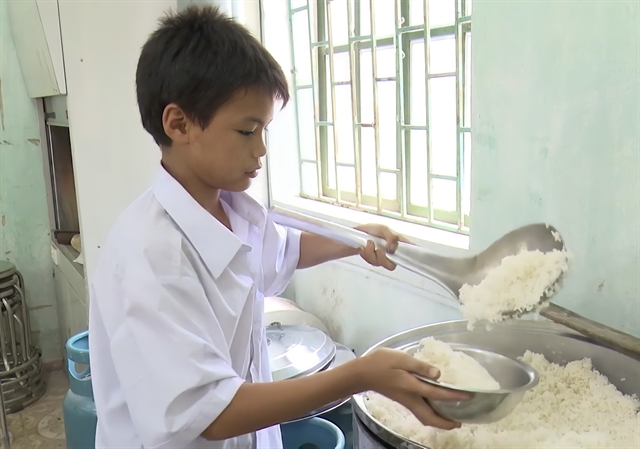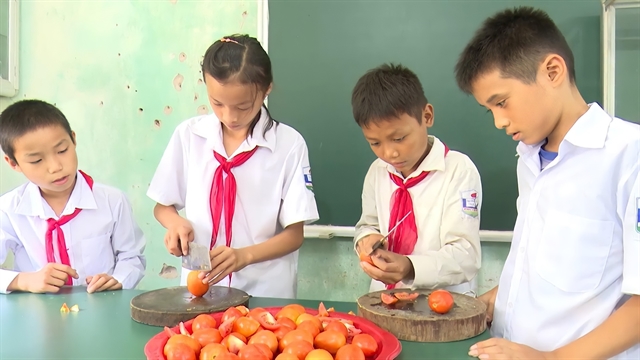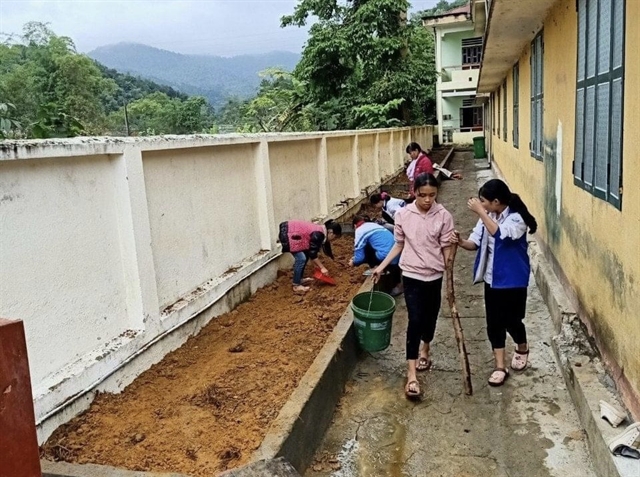Bảo Ngọc
The idea of Từ Thanh Phương, principal of the Phương Độ Secondary School in Hà Giang Province, for a self-sustaining school has helped hundreds of poor ethnic students continue to fulfill their dream getting an education.
Phương Độ is a suburban secondary school about 4km from Hà Giang city centre, with 200 students, mainly ethnic minority children in highland communes living in extremely difficult conditions.
Due to dangerous terrains and lack of transportation, many students have to get up at 3 or 4am to walk to school.
Understanding the difficulties of these poor students, Phương has built this self-sustaining model for about 60 of 200 students in the school. Accordingly, ethnic children who live far away and have difficult family circumstances can temporarily stay and study at school from Monday to Friday and return home at weekends.
Because the students are in difficult circumstances with limited money, in order to reduce the financial burden on their families, the school has guided them in self-catering.

Under the guidance of teachers, the students are able to cook by themselves. — Photo courtesy of hagiangtv.vn
At mealtimes, there is only one instructor and students have to cook, arrange food trays, wash dishes and do laundry themselves.
The children also participate in growing vegetables on the school campus and cleaning their own bedrooms.

Ethnic students prepare their own meals every day. — Photo courtesy of hagiangtv.vn
"The ethnic students here are used to hard living conditions, so they adapt very quickly. Their cooking skills are even better than those of older children," Phương says.

Growing vegetables at the school campus. — Photo courtesy of hagiangtv.vn
Phương says that the reason for establishing this model comes from her love for students, her desire to reduce the burden on their parents and her hope that the children can be more independent in their future lives.
“I do not care about how many of them can participate in the provincial competition for excellent students, but I hope they can improve their life skills and be more independent in the future,” she says.
"Of course, if students can get good grades and be good at life skills at the same time, that is great.”
Difficulties remain
Each month to join hands with the school in paying for food and accommodation, each parent must contribute from VNĐ300,000 to 400,000.
Thus, each child's daily meal costs only VNĐ18,000 divided among three meals, which barely meets the nutritional requirements, and usually consists of vegetables, tofu, peanuts, very little meat, and eggs.
Therefore, in addition to building the self-sustaining model, the school also asks for support from organisations, sponsors and sometimes even teachers themselves to ensure the students get meals.
According to Nguyễn Thị Quỳnh, a teacher at the Phương Độ Secondary School, every month each teacher contributes VNĐ50,000 to the student support fund and takes turns on duty at the school to teach them life skills outside of school hours.
"Up to 30 per cent of ethnic children boarding here cannot afford the cost of meals and may have to drop out of school,” Quỳnh says. “So, all of us teachers want to contribute something to help them continue to go to school.”
Quỳnh, although only assigned to teach English at this secondary school three times a week, understands the difficulties of the teachers and students here. She says that students now face a lot of obstacles in homeschooling due to the recent citywide lockdown.
"Ethnic families do not have computers and smartphones for their children to study online at home during the pandemic. So teachers have to make small homework books, then print them out and ask the village chiefs to deliver them to each student's house," she says.
“At the end of the week, we collect the homework books, mark them and hand out another book for the following week. Many students before returning home due to the pandemic told me that they did not want to leave school because going home meant they would have less food to eat. That made me sad for a long time.”
The idea for a self-sustaining school was upgraded by Phương from the model of the semi-boarding schools sustaining local people, which appeared in Việt Nam in the 1960s when times were even tougher.
Along with the change and development of the country, more and more parents voluntarily send their children to school, and the number of semi-boarding schools for ethnics is growing fast.
The local self-sustaining schools are diverse, based on the specific conditions of each place. Sometimes parents prepare lunch boxes for their children to bring to school, or contribute food and fuel or cook extra soup at the schools.
With smart, innovative models of schooling on the rise, life will hopefully get better for the children of the country’s ethnic minorities. — VNS
OVietnam